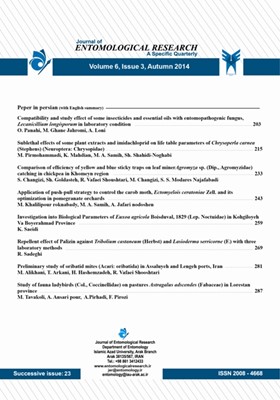-
-
List of Articles
-
Open Access Article
1 - Compatibility and study effect of some insecticides and essential oils with entomopathogenic fungus,in laboratory condition
O. Panahi M. Ghane Jahromi A. Loni -
Open Access Article
2 - Sublethal effects of some plant extracts and imidachloprid on life table parameters of Chrysoperla carnea (Stephens) (Neuroptera: Chrysopidae)
M. Pirmohammadi K. Mahdian M. A. Samih Sh. Shahidi-Noghabi -
Open Access Article
3 - Comparison of efficiency of yellow and blue sticky traps on leaf miner Agromyza sp. (Dip., Agromyzidae) catching in chickpea in Khomeyn region
S. Changizi Sh. Goldasteh R. Vafaei Shoushtari M. Changizi S. S. Modares Najafabadi -
Open Access Article
4 - Application of push-pull strategy to control the carob moth, Ectomyelois ceratoniae Zell. and it,s optimization in pomegranate orchards
M. Khalilipour roknabady M. A. Samih A. Jafari nodoshen -
Open Access Article
5 - Investigation on some biological parameters of the tumbleweed moth Euxoa agricola Boisduval, (Lep. Noctuidae)
K. Saeidi -
Open Access Article
6 - Repellent effect of Coconut soap (Palizin) against Tribolium castaneum (Herbst) and Lasioderma serricorne (F.) using three laboratory methods
R. Sadeghi -
Open Access Article
7 - Preliminary study of oribatid mites (Acari: oribatida) in Assaluyeh and Lengeh ports, Iran
M. Alikhani T. Arkani H. Hashemzadeh R. Vafaei Shooshtari -
Open Access Article
8 - Study of fauna ladybirds (Col., Coccinellidae) on pastures Astragalus adscendes (Fabaceae) in Lorestan province
M. Tavakoli A. Ansari pour A. Pirhadi F. Pirozi
-
The rights to this website are owned by the Raimag Press Management System.
Copyright © 2021-2025







